#License Nepal
Text
Congratulations to Nepal!
Here's a brief history leading up to today.
Nepal has tried to stamp out social discrimination ever since a decade-long Maoist rebellion ended in 2006 and the 239-year-old Hindu monarchy was dismantled in 2008.
In 2007, Nepal repealed laws against gay sex and introduced several laws which protected "gender and sexual minorities". The Supreme Court ruled later that year for the government to create laws to protect LGBTI rights, and for the government to form a committee to look into legalizing same-sex marriage. Successive governments failed to change the law on same-sex marriage.
A lesbian couple held a traditional Hindu marriage ceremony in 2011, but the marriage has no legal status in Nepal. More and more public parades and unofficial weddings started being held in Nepal.
A new constitution was adopted in 2015 which recognized LGBT rights as fundamental rights, and while it didn't specifically list same-sex marriage, it did list several other rights, such as being able to acquire a citizenship certificate according to one's gender identity.
In July 2017, Monica Shahi and Ramesh Nath, successfully registered their marriage. Shahi is a third gender person, with their sex recorded as "other" on their official identity documents. The Nepal Home Ministry said the marriage could be invalid.
In October 2017, the Supreme Court ruled that the government was wrong to deny a Visa to the American wife of a Nepalese citizen. The government argued it rejected the application since Nepal doesn't recognize same-sex marriages. The Supreme Court ruled that the law is as long as they have a valid marriage license, a foreigner who is married to a Nepali citizen is eligible for the Visa, the rules do not specify that the foreign national must be either same or opposite gender. Furthermore, it pointed to the Nepal constitution that an LGBT citizen is entitled to live life with dignity without discrimination.
March 2023, the Supreme Court ordered the government to recognize the marriage of a Nepali citizen and his German husband and to issue a spousal visa. It also directed the government to draft legislation for full marriage equality in Nepal
In June of 2023, the Supreme Court ordered the government to make necessary arrangements to temporarily create a separate register for marriages of "sexual minorities and non-traditional couples" until lawmakers come up with a new legal framework to uphold such unions permanently.
Nov 29, 2023, a same-sex couple officially registered their marriage
36 notes
·
View notes
Text
Nightmare Nightmore Highlights.
I'm not gonna recap or analyze the episode too much I just wanna share a few of my favorite things! Not really any spoilers, if you've already seen the leaks of Abbey and her mom floating around then you're all caught up.
Draculaura is throwing a party for the holiday of Nightmore, but I couldn't possibly care less. I'm here for Abbey!

Heath has the same reaction to seeing Abbey for the first time as a lot of us did. in Awe of her beauty. same dude, same.

She towers over everyone! even the boys! I am in love!
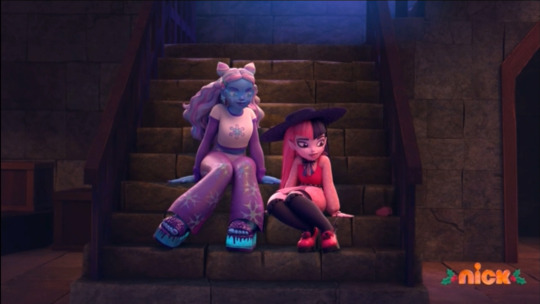
Draculaura is like a smurf compared to tall powerful Abbey.

Abbey's eyes aren't purple anymore, they are brown! and so pretty! breaks up the abundance of purple in her hair and outfit I am super into it!

Abbey's hair blend is the colors of the Bi flag and I have no choice but to stan.

Mama Bominable threatening to bring forth a cold harsh merciless winter upon Bloodgoods head if she doesn't produce Abbey is such a mood. I love me a good mama bear.

WHERE IS NIGHTMARE!? why is this messenger dragon hanging out in Bloodgood's office but her horse isn't!? The episode even has nightmare in the title but I see no Nightmare the horse. I don't like it. A headless horse person without their horse is just a zombie... why are you booing me? I'm right!
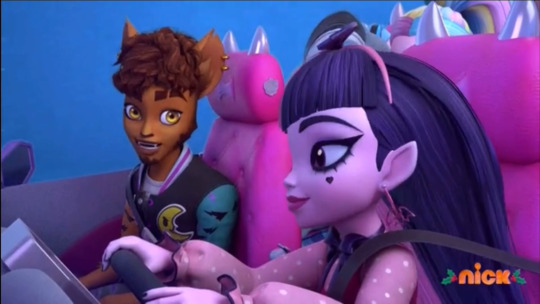
Draculaura already has her license in this gen? I'm here for it! Also Clawd chose to sit next to her. Also Clawd said "nailed it like a coffin" which was only ever said in G1 by Clawdeen and that makes me happy.
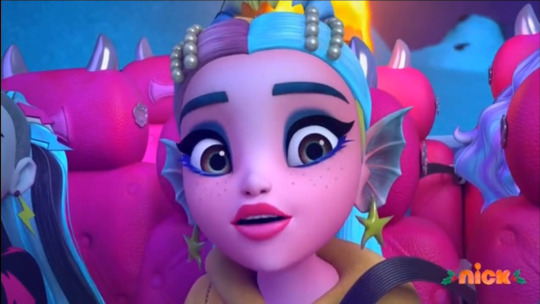
This is the second or third episode where Lagoona inexplicably has flat teeth, the music video for her doll did this too. I'm not exactly a professional animator but I've studied it enough to know that rendering characters off model is a fire-able offense. Fix it Nickelodeon.
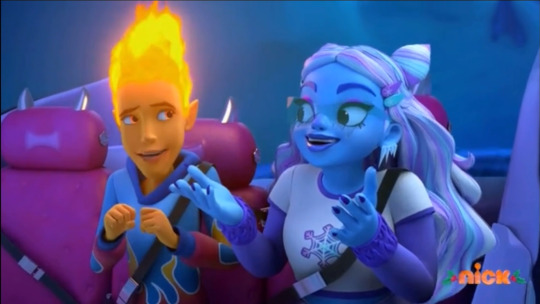
Heath encouraging Abbey to use her ice powers telling her she is strong, charismatic and beautiful. ahhhh! my heart!... I've mentioned on here I'm not much of a shipper per-se. But that was a lie, Habbey was one of my OG ships and it brings me such joy to see them again! I needed this since the only Heath we got during G2 was this:

*Long suffering G2 sigh*
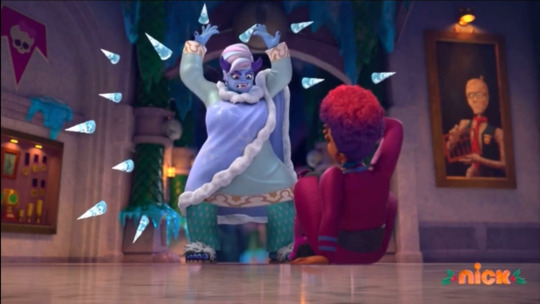
Yeti's in this universe seem to basically be water benders and I am okay with that! Mama Bominable is fuckin pissed! LOL Bye Bloodgood it's been nice knowing you!

Damn, Abbey's dad didn't contribute any genetics to that her at all. Mama Bominables genes were like "this is MY child!" I do love that she has horns and a more pronounced underbite, perhaps Abbey will get these traits as she grows? Or maybe her buns are hiding her horns? IDK but it's fun to imagine! I wonder where they got the idea to give their yeti Horns... HMMMMMMM

it's a mystery, we'll never know.

This isn't even a highlight I'm just taking pictures of Mama Bominabe at this point, I love a strong woman willing to murder the school principle for her daughters safety.

SHE CALLED ABBEY SNOW ANGEL AHHHHHH- I'm sorry I just had to get that out.

The boy is in love! .... And he actually says something really profound. I'm so impressed G3 is giving Heath some depth and not just making him a one note idiot... Don't get me wrong, I liked one note idiot Heath but there was more to him than that.

Heath trying to kiss Abbey on the first day of meeting her is absolutely a G1 call back.

in her intro episode he kissed her hand and his lips froze off.
I love everything about this episode! I love that Abbey is Nepali! it's way more accurate to her Monster type and before some nerd tries to get in the replies and go "Actually Russia occupied Nepal at one point" that's true, they did BUT! the myth of the Yeti originated in 1937, Russia didn't occupy the Himalayas until the 1960's.
This episode is my new favorite! I heard a rumor that we won't get any new Monster High episodes until after the new year, but if they are anything like this? they will be worth the wait!
258 notes
·
View notes
Text
Khukurī (kukri) types and accessories
[a compilation of articles by Peter Dekker, Mandarin Mansion Antiques, 2020; text and photographs licensed under a Creative Commons Attribution 4.0 International License]
The Khukurī (खुकुरी )

A Nepalese khukurī, 1850s
The khukurī (खुकुरी) is the traditional utility and fighting knife of Nepal. It is strongly associated with the Ghurkas, a Nepalese soldier class. Khukurī are characterized by a forward curving blade that widens considerably before forming a fairly sharp point.
The knife goes by many names, but the best-established names and their romanization are khukurī (खुकुरी ) and the simpler khukri (खुक्रि), both appear in comparative and etymological dictionary of the Nepali language of 1931. [1] The simplified word kukri is in common use today, mainly among English speaking collectors.
18th century
The first few reliable images we get of early khukurī are two 18th century pieces, exhibiting striking similarities even though one is in a Chinese collection and the other was illustrated by an English expedition party.
First, an 18th-century khukurī that appears in the Palace Museum collection in Beijing.1 It was probably captured in battle or presented during the signing of a treaty during the Tibet-Ghurka conflicts of 1788-1792.
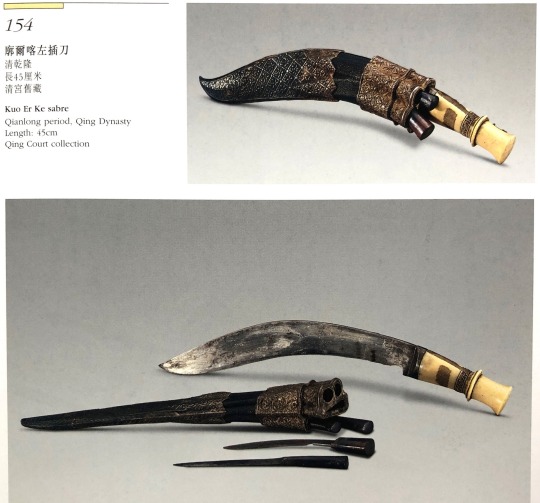
Khukurī in the Palace Museum collection, Beijing.
The relatively narrow handle with minimal flare in the pommel is also seen on Kirkpatrick's depiction of the khukurī, the first such illustration to appear in European sources.
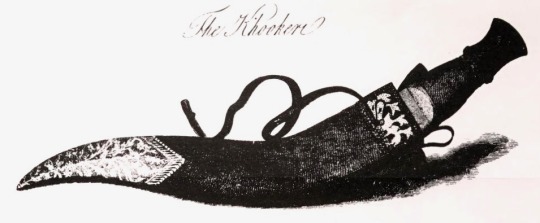
Early illustration of a khukurī. From Colonel Kirkpatrick's 1793 account of Nepal.
Another early piece, most likely the late 18th century, was obtained by Lord Egerton in 1855. It was published in his book Indian and Oriental Arms and Armour and is now in the Victoria & Albert Museum. V&A accession number: 3095(IS).

One of the Egerton khukurī
This piece has some early features like the shallow kauro (notch), and the overall form of hilt and blade. The workmanship looks Indian, and it may have been made by Indian craftsmen.
19th century
Some well known early 19th-century depictions of khukurī are in the Fraser Album. A few of them were actually made, commissioned by William Fraser (1784-1835), a late Mughal era British India civil servant in Delhi.

"Nepali soldiers" from the Fraser Album, published 1819.
Notable features seen on khukurī in these drawings are:
Long hilts with gently flaring pommels
Black enbroidered scabbards with small chape
A recurved shape to the scabbard
Types
Hanshee khukurī (हँसिया खुकुरी)
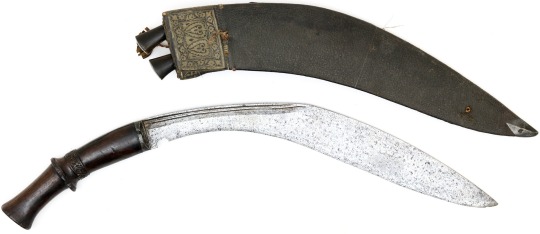
The hanshee khukurī or simply hanshee is an early type of khukurī that is characterized by having a long hilt and a rather long and relatively narrow blade with a strong curve. Other than most types of khukurī which double as fighting and utility knife, the hanshee appears to have been purely used as a weapon.
The word hanshee derives off the Nepali word hamsiyā (हँसिया) meaning "sickle". Another term used is lambendh, which supposedly means "long handle" containing the word lambe (लम्बे) meaning "long" in Nepali.
The hanshee appears to have been most popular in the late 18th and early 19th century and seems to have fallen out of use by the mid 19th century. Khukurī researcher V.K. Kunwor of Ghurka antiques writes about the hanshee: "These Kukri knives were very popular in the unification period of Nepal (1750-1770) and continued to be used in the Anglo-Nepal War 1814-1816 and up till the Indian Mutiny 1857, from whence it declined in popularity." He also writes that one of the defining features is a handle length of at least 13 cm.
Budhunē khukurī (बुधुने खुकुरी)

The fat-bellied budhunē khukri (bottom) compared to a more conventionally proportioned khukri (top)
Budhunē khukurī (बुधुने खुकुरी) is the name of a variation of khukri with a short, broad blade. It is a term that appears in the Comparative and etymological dictionary of the Nepali language of 1931.
Bhojpure subtype: The term Bhojpure turns up in John Powell's unfinished manuscript on the khukurī. Powell notes that it is a term later in use for the earlier budhunē type.
Well known khukurī researcher Viking Kunwor, writing in 2020 adds: "The Bhojpure (from a town (Bhojpur) in the mid hills of eastern Nepal) is one of several styles within the larger Budhume group (a term which is a based on a broad bellied fish spieces). The many tribes can be attributed to these weapons such as Limbus and Rais make only the deeper bladed Bhojpure, the Gurungs, Tamangs and Chhetris make the seerpat and the Newars are the artisans who are responsible for many of the finely carved wooden scabbards, intricate decoration and engraved blades."
Sirupātē khukurī (सिरुपाते खुकुरी)
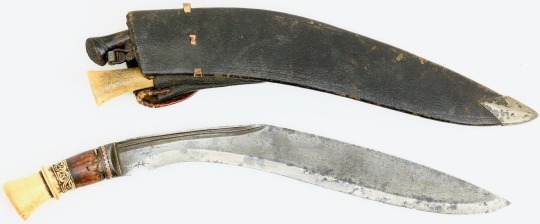
A sirupātē khukurī of the early 1800s.
Sirupātē (सिरुपाते) is a word commonly used to describe a long, slender version of a Nepalese khukurī.
The word sirupātē (सिरुपाते) appears in Ralph Lilley Turner’s A Comparative and Etymological Dictionary of the Nepali Language of 1931 and is described as: "सिरु-पाते siru-pāte,adj. Long and slender like a blade of siru"
Siru (सिरु) is the name of a local plant. Pātē (पाते) means "leaf". Turner gives the meaning for siru (सिरु) as the name of two varieties of grass or reed: (1) Imperata arundinacia (= khar-siru, used for thatching); (2) Imperata arundinacia var. latifolia. (Another possibility may be Hypoxis aurea which is called ban siru (बन सिरु) locally.)
Kothimora khukurī (कोथि मुहुड़ा खुकुरि)
Kothimora khukurī refers to a khukurī in an ornamental scabbard, usually with elaborately worked silver mounts but sometimes found in silver with parcel gilding or entirely golden mounts as well. 1
The term primarily applies to the scabbard, there may be a very mundane khukurī inside, although in some cases they were produced together and both of a higher than usual quality.
The word consits of kothi (कोथि), and muhura (मुहुड़ा). Kothi (कोथि) is the Nepali word for the silver chape on the scabbard of a khukurī. 2
Muhura means “face”. Colonel J.P. Cross states that the full wording would be “kothimora dap bha'eko khukurī”. This would literally translate to "silver chape face scabbard done khukurī", written in Nepali it is कोथिमुहुड़ा दाप् भएको खुकुरी.
John Powell, a pioneer in khukurī studies, distinguished three main types: The "Palace or Court kothimora", "regimental kothimora" and the "box kothimora". He also noted that many do not fall into these set categories, and those can just be referred to as kothimora khukurī.
Palace or Court kothimora: Usually with black leather covered scabbard with gold or silver scabbard mouth and endpieces. Each fitting worked in repousse or engraved, frequently with the National Coat of Arms of Nepal.
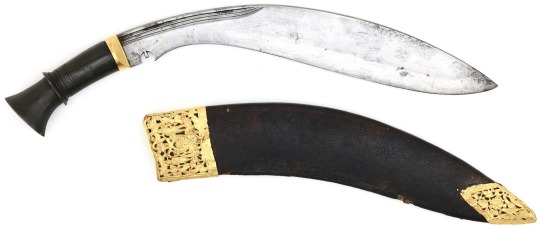
Palace or Court Kothimora khukurī
Regimental kothimora: The most commonly encountered type. These were primarily made for Ghurka soldiers. Powell describes that sometimes these were just regular fighting khukurī that were brought to the metal worker to fit the scabbard with a fancy dress, usually in repousse silver, as an honour permitted to men of valor.
As military weapons, they sometimes come with regimental insignia, but are more often encountered decorated with traditional local elements. Their wooden scabbards can be covered with leather or silk velvet.

A large kothimora khukurī.
According to Powell, in the British Indian army, regimental kothimoras were worn only by the Pipe Major (senior bagpiper) when on parade and senior NCO and ORs of the Officer's Mess. They were also presented to retiring Ghurka officers, or when an officer moved up rank.
Box kothimora: The main defining feature of this type is that the scabbard does not have separate leather or fabric pockets for karda and chakmak, it is all integrated in a single case, often clad in sheets of silver going around the circumference of the scabbard, and with mouthpiece and endpiece much like the regimental kothimora. These seem to have been primarily pieces that were presented to civilians.
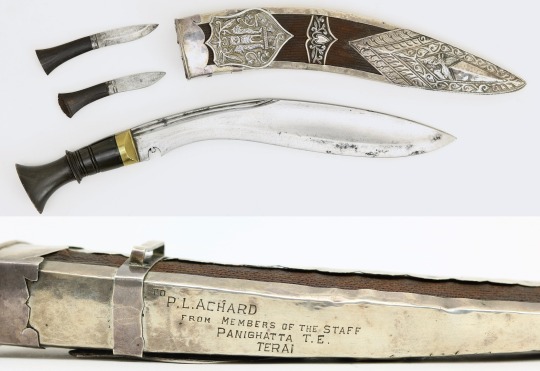
A box kothimora khukurī presented to wildlife conservationalist Peter L. Achard between 1947-1966.
Accessories

a "trousse khukurī" of the first half of the 20th century
Some items are often stored in the khukurī scabbard alongside the main knife.
Karda (कर्द)

Karda (कर्द) is the Nepali word for a small utility knife that was traditionally carried in the scabbard of a khukurī. The term comes from the Persian word kard (کرد), meaning "knife". A typical khukurī carries one, but some carry two of them in their scabbards.
Karda typically follow a similar construction as their parent khukurī, with wood, horn, bone, silver or ivory hilts and a metal bolster. The blades are usually more straight than khukurī.
Cakmak (चक्मक्)

Left: Five cakmak, right: Five karda. Notice the subtle differences at the pommel side and the absence of an edge bevel on the cakmak.
Cakmak (चक्मक्) is the Nepali word for a small knife-shaped fire and sharpening steel that was traditionally carried in the scabbard of a khukurī. [N.B. must be from Ottoman Turkish چاقماق / Turkish çakmak, "firestriker" (and later "lighter") < Common Turkic *čak- (“to strike”)]

The worked pommel ends of cakmak.
Cakmak typically follow a similar construction as their parent khukurī, with wood, horn, bone, silver or ivory hilts and a metal bolster. For easy recognition when sheathed, the back of the hilt is often grooved or ribbed, in contrast to the smoother backs of the typical karda.

The decoration helps differentiate them from the smooth-pommeled karda when sheathed.
The blades are usually shaped like a straight knife, but sometimes also shaped like a khukurī profile. Contrary to the karda, blades on cakmak are typically dull.
Khisā (खिसा)

Khisā (खिसा) is the Nepali word for a small purse that was traditionally carried in the scabbard of a khukurī.
The purse was usually used to hold tinder consisting of the bark of the sago palm, bamboo, or plantain. The tinder was called jhulo (झुलो), literally meaning "fiber".
— Peter Dekker, Mandarin Mansion
196 notes
·
View notes
Text
Month of Saiyuki (day 20)
The Saiyuki boys are in the zombie apocalypse. Who would live the longest?

Despite his human nature, Sanzo is more than able to survive such apocalypse, he also has hunting skills:

Hakkai is another good candidate to live the longest, he can take advantage of the environment, he can heal and is able to survive in the woods:

Goku might have some difficulties but overall he would manage to make it through. If he becomes Seiten Taisei zombies shall pray to survive.
Sorry Gojyo, good fighting skills but he has also a very delicate stomach and seems to prefer a refined lifestyle. With the help of others he can manage to survive.
And now a moment of nerding XD (sorry for long post)
Since I love to analyse things from small details and in this particular case I love to speculate where Sanzo Ikkou is, I've noticed two elements that might give me info about the location. A good indicator is given by Hakkai when he mentions the caterpillar fungus (Ophiocordyceps sinensis). While trying to restrict the areal distribution of this fungus I found this article A survey of the geographic distribution of Ophiocordyceps sinensis by Yi Li , Xiao-Liang Wang, Lei Jiao, Yi Jiang, Hui Li, Si-Ping Jiang, Ngarong Lhosumtseiring, Shen-Zhan Fu, Cai-Hong Dong, Yu Zhan, Yi-Jian Yao. As the title says this study tries to identify the geographic distribution of this fungus used in Tradition Chinese medicine, and I found this map:

This is the link to the original study, but if you want to the entire pdf, there it is: https://docslib.org/doc/11833369/a-survey-of-the-geographic-distribution-of-ophiocordyceps-sinensis
Like the abstract states the fungus can be found in the Tibetan Plateau and its surrounding regions, including Tibet, Gansu, Qinghai, Sichuan, and Yunnan provinces in China and in certain areas of the southern flank of the Himalayas, in the countries of Bhutan, India and Nepal and it is mainly found in the meadows above 3,500 metres.
Another key element that makes me think they might be between Tibetan Plateau and Bhutan is the lagomorph Sanzo is holding by the ears. The possible candidates are: Indian hare (Lepus nigricollis), Woolly hare (Lepus oiostolus) and Hispid hare (Caprolagus hispidus). I immediately rule out the hispid hare because its ears are very short and do not project beyond the fur. The Indian hare is not present in the Tibetan Plateau despite being present in southern part of Bhutan:

Indian Hare area.png by Chermundy, 14 December 2010, is licensed under the Creative Commons Attribution-Share Alike 3.0 Unported license. Attribution: IUCN Red List of Threatened Species, species assessors and the authors of the spatial data.
So the most likely candidate is the woolly hare whose distribution is:

Woolly Hare area.png by Chermundy, 14 December 2010, is licensed under the Creative Commons Attribution-Share Alike 3.0 Unported license. Attribution: IUCN Red List of Threatened Species, species assessors and the authors of the spatial data.
If you want to know more about this hare species here a nice link:
As for the even-toed ungulate we can see, it's a bit difficult a possible identification. The animal might be a member of Cervidae family, maybe an Indian muntjac (Muntiacus muntjak) but yeah without a full picture of the head and antlers it's just a speculation.
Sooooo all of this just to say they are most likely between Tibet and Bhutan XD. Thank you for coming to my Ted Talk. In future I want to talk more about the caterpillar fungus mentioned in these pages. There's a lot to say about this fella.
#saiyuki#kazuya minekura#minekura kazuya#genjyo sanzo#genjo sanzo#month of saiyuki#cho hakkai#son goku
3 notes
·
View notes
Text
All the books I reviewed in 2022 (Part II: Books for young people)


I. Pixels of You, by Ananth Hirsh, Yuko Ota and Jenn Doyle
A sweet, smart tale of art, bitterness, enmity and camaraderie, packagaged as a YA sf graphic novel. Pixels is a buddy story, one where the irreconcilable is reconciled, where hate flips to love and back again, and where art is debated, created, destroyed and finally remade — where one buddy is an orphaned cyborg with a digital eye, and the other is a human-presenting AI desperate to fit in.
https://pluralistic.net/2022/02/08/wall-street-landlords/#young-doyler

II. Crazy in Poughkeepsie by Daniel Pinkwater
A standalone, demi-sequel to 2020’s “Adventures of Dwergish Girl,” a YA novel about a sort-of Catskills leprechaun girl whose coming of age involves moving to human civilization, learning the art of pizza-making, getting involved with community radio, venturing to New York City to drink papaya juice and learn mystic secrets from a junk-store owner, and, ultimately, resolving an existential threat to human civilization based on weaponizing a large cohort of Civil War ghosts (she gets help from an ancient witch).
In “Crazy,” Pinkwater introduces us to Mick, who’s just come home from his first overnight camp experience. While he was away, his older brother, Maurice, has gone trekking in Nepal to find a guru (Maurice has been sold on gurus from superhero comics where having a guru is a surefire way to acquire mystical powers).
https://pluralistic.net/2022/04/12/klong-you-are-a-pickle/#who-you-calling-weird

III. The Big Box of Sparkly Unicorn Magic by Dana Claire
A boxed set that includes the first four ‘Phoebe and Her Unicorn’ bound together in a fat, satisfying paperback, that’s big enough to feel exciting, but not too big for small hands to grasp. The ‘Phoebe’ books tell a hilarious, sweet, and unsentimental story about a kid and her imaginary friend ripped straight from the Calvin and Hobbes playbook, but with new, lateral moves that are strictly her own —anarchic kid humor, snarky adult humor, slightly over-their-head jokes that kids enjoy once they’re explained. Included in this anthology is the third Phoebe and Her Unicorn book, Unicorns vs Goblins, which contains the introduction my daughter Poesy and I co-wrote.
https://pluralistic.net/2022/06/05/heavenly-nostrils/#better-than-calvin
Next up: Nonfiction (part 1)
https://mostlysignssomeportents.tumblr.com/post/702452370056101888/all-the-books-i-reviewed-in-2022-part-ii
Image:
Matthew Petroff
https://commons.wikimedia.org/wiki/File:George-peabody-library.jpg
CC BY-SA 3.0
https://creativecommons.org/licenses/by-sa/3.0/deed.en
[Image ID: Interior of the George Peabody Library in Baltimore.]
10 notes
·
View notes
Text
Everest Base Camp Trek - Conquer the Roof of the World!
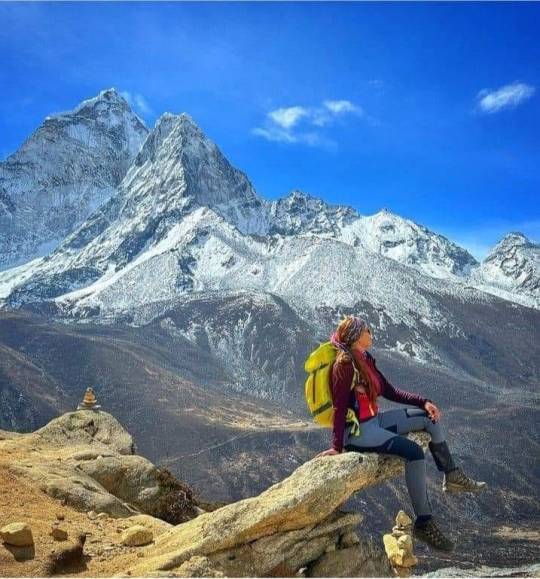
🏔️ 📅 Trip Duration: 14 days
📍 Destination: Nepal
🏞️ Trip Difficulty: Strenuous
🚍 Transport: Kathmandu - Lukla - Kathmandu
🍽️ Meals: Breakfast, Lunch & Dinner (BLD) during the trek 🏠
Accommodation: Cozy Teahouses & Lodges
👥 Group Size: Small & Personalized (Min. 1 / Max. 15)
⛰️ Max Elevation: 5,364m - Everest Base Camp
⏰ Walking Hours: 5-7 hours daily
🏁 Start/End: Kathmandu/Kathmandu
🚶♂️ Trekking Type: Local Lodge-based Tea House Trek
🌈 Best Season: February to May, September to December
🌟 TRIP HIGHLIGHTS
Trek to the base camp of the world's highest mountain, Mount Everest.
Experience the breathtaking beauty of the Khumbu region.
Witness stunning panoramic views of Everest, Lhotse, Nuptse, and more.
Explore the Sherpa culture and traditions in mountain villages.
Visit the famous Tengboche Monastery and receive blessings for a successful trek.
Travel with a small group for an intimate and personalized experience.
📋 DETAILED ITINERARY
Day 1: Arrival in Kathmandu Arrive in Kathmandu,
the bustling capital of Nepal. Meet your trekking guide and fellow adventurers. Rest and prepare for the exciting journey ahead.
Day 2: Flight to Lukla, Trek to Phakding (2,651m)
Take a thrilling flight to Lukla, the gateway to the Everest region. Embark on the trek to Phakding, passing through picturesque landscapes.
Day 3: Trek to Namche Bazaar (3,440m)
Continue the trek along the Dudh Koshi River. Climb up to Namche Bazaar, the vibrant Sherpa trading hub.
Day 4: Acclimatization Day in Namche Bazaar
Acclimatize to the increasing altitude in Namche Bazaar. Explore the town and enjoy panoramic views of Everest and surrounding peaks.
Day 5: Trek to Tengboche (3,867m)
Trek through rhododendron forests and reach the Tengboche Monastery. Experience the serene ambiance and panoramic mountain vistas.
Day 6: Trek to Dingboche (4,260m)
Descend to Debuche and cross the Imja River. Climb uphill to Dingboche, a beautiful village surrounded by mountains.
Day 7: Acclimatization Day in Dingboche
Take a day to acclimatize in Dingboche. Hike to Nagarjun Hill for breathtaking views of Ama Dablam and Lhotse.
Day 8: Trek to Lobuche (4,930m)
Trek through the moraines of the Khumbu Glacier. Reach Lobuche, a popular stop before reaching Everest Base Camp.
Day 9: Trek to Everest Base Camp (5,364m) and Gorak Shep (5,140m)
Ascend to the ultimate destination, Everest Base Camp. Witness the majestic Khumbu Icefall and the towering Everest. Descend to Gorak Shep for overnight stay.
Day 10: Hike to Kala Patthar (5,545m),
Trek to Pheriche (4,371m) Early morning hike to Kala Patthar for a stunning sunrise view over Everest. Descend to Pheriche, another beautiful Sherpa village.
Day 11: Trek to Namche Bazaar Trek back to Namche Bazaar,
enjoying the scenic landscapes. Relax and celebrate the successful completion of the trek.
Day 12: Trek to Lukla Continue the trek to Lukla,
the last leg of the journey. Reflect on the incredible adventure and bid farewell to the mountains.
Day 13: Flight to Kathmandu Fly back to Kathmandu and transfer to your hotel. Rest and celebrate the achievement of reaching Everest Base Camp.
Day 14: Departure Say goodbye to Nepal,
carrying with you unforgettable memories. Depart with a sense of accomplishment and a love for the Himalayas.
💰 COST INCLUDES
Airport transfers upon arrival and departure.
Domestic flights (Kathmandu - Lukla - Kathmandu) with airport taxes.
Accommodation in a 3-star hotel in Kathmandu with breakfast.
Tea house or lodge accommodation during the trek.
All meals (Breakfast, Lunch & Dinner) during the trek.
Licensed English-speaking trekking guide.
Porter service (1 porter for 2 trekkers) to carry your trekking gear.
Sagarmatha National Park Entry Permit.
TIMS card (Trekker's Information Management System).
All government taxes and official expenses.
🚫 COST EXCLUDES
International airfare to and from Kathmandu.
Nepal entry visa fees (available upon arrival at Kathmandu airport).
Travel and rescue insurance (mandatory).
Personal expenses such as additional meals, drinks, and snacks.
Tips for trekking staff (guide, porter, etc.).
Any extra costs incurred due to unforeseen circumstances (natural disasters, flight delays, roadblocks, etc.).
Any services not mentioned in the "Cost Includes" section.
🗨️ FOR MORE INFORMATION AND BOOKINGS, CONTACT US: Email: [email protected] WhatsApp: +977-9808262524
https://www.missionsummittreks.com/trip/everest-base-camp-trek/
🌄 Embark on a journey to conquer Everest Base Camp! 🌄
2 notes
·
View notes
Text

Manaslu Circuit trek is an alternative trekking route of Annapurna Circuit Trek, but it is a restricted area as per the rule and regulations of the Nepal Government. So, it is not allowed to trek in the Manaslu Region without a guide. Therefore, the government has made it compulsory to have a guide for Manaslu Circuit Trek and that you must hire a guide and have at least two members in your Trekking Group, excluding the guide to issue the trekking permits for the Manaslu trek. That is why, you must hire a guide for the Manaslu Circuit Trek. The hiring guide must be with trekking licensed from the Nepal government.
#nepal#travel#highpassadventure#adventure#everest#annapurna#trekking in nepal#travel and tourism#treks#nepaltrekking#manaslu region#manaslu circuit trek#Manaslu#Hiking#hiking adventure#trekkinginnepal#vacation#travelling#tourist#explore#travelblogger
2 notes
·
View notes
Text
What is the difficulty level of Nar Phu Valley Trek?
The Nar Phu Valley Trek is a remote and less explored trekking route in the Annapurna region of Nepal. The trek takes you through the Nar and Phu valleys, which are located in the northernmost part of the Manang district. The trek offers a unique opportunity to explore the rugged terrain, stunning landscapes, and ancient Tibetan culture of the region.
The trek is usually a 16-day itinerary that starts and ends in Kathmandu. The trail takes you through lush forests, steep ridges, high passes, and remote villages, including Nar and Phu villages. These villages are inhabited by people of Tibetan origin and offer a unique glimpse into the traditional lifestyle, culture, and architecture of the region.
The trek also offers stunning views of the Himalayas, including Annapurna, Dhaulagiri, Lamjung, and Manaslu. The highest point of the trek is the Thorong La Pass (5,416m), which offers panoramic views of the surrounding mountains.
Hiring a guide for the Nar Phu Valley Trek is highly recommended, as it will enhance your safety, provide cultural insights and local knowledge, and make your trek more enjoyable.
A licensed guide can help you navigate the challenging terrain, manage the logistics of your trek, and provide information about the local culture, history, and environment. They can also assist you in case of any emergencies and ensure that you have a comfortable and enjoyable trekking experience.
You can find licensed guides through various trekking agencies in Nepal or hire an independent guide. When hiring a guide, it's essential to ensure that they have proper training, experience, and are licensed by the Nepal Tourism Board. It's also recommended to read reviews and ask for recommendations from other travelers who have done the Nar Phu Valley Trek before.
If you're planning a trek or any kind of travel in Nepal, it's highly recommended to hire a licensed guide. A licensed guide can provide valuable insights into the local culture, customs, history, and environment, as well as ensure your safety and comfort during your trip. Here are some tips for finding a guide in Nepal:
Look for licensed guides: Make sure to hire a licensed guide who is registered with the Nepal Tourism Board. This ensures that they have undergone proper training, are knowledgeable about the area, and have the necessary skills and experience to guide you safely.
Check reviews and recommendations: Read reviews and ask for recommendations from other travelers who have used the services of a guide in Nepal. This will give you an idea of the guide's reliability, expertise, and level of service.
Choose a guide based on your interests: Consider your interests and choose a guide who has knowledge in the areas that interest you. For example, if you're interested in trekking, choose a guide who specializes in trekking.
Negotiate a fair price: Negotiate a fair price with your guide before hiring them. Prices can vary depending on the level of service you require and the length of your trip.
Meet the guide in person: If possible, try to meet your guide in person before hiring them. This will allow you to get a better sense of their personality, communication skills, and level of experience.
hiring a licensed guide in Nepal is highly recommended for a safe, enjoyable, and culturally rich travel experience.
2 notes
·
View notes
Text
Batumi Shota Rustaveli State University: Affordable MBBS Fees in Georgia for Aspiring Doctors
Batumi Shota Rustaveli State University (BSRSU) is one of the leading universities in Georgia, offering a globally recognized MBBS program with top-notch facilities and experienced faculty. For international students, BSRSU stands out as an excellent choice for medical education, particularly due to its affordable MBBS fees and high-quality academic standards. Located in the beautiful coastal city of Batumi, the university combines world-class education with a welcoming environment.
Why Choose Batumi Shota Rustaveli State University?
BSRSU is well known for its comprehensive MBBS curriculum, which is designed to meet international standards. The MBBS in Georgia at Batumi Shota Rustaveli State University is recognized by major medical bodies such as the World Health Organization (WHO), the Medical Council of India (MCI), and others, making graduates eligible to practice medicine in numerous countries, including India, the UK, and the USA.

Key highlights of studying MBBS at BSRSU:
English-taught Program: The MBBS program is taught entirely in English, making it accessible to international students from various countries.
Modern Infrastructure: The university boasts modern medical laboratories, state-of-the-art facilities, and hands-on training, ensuring students gain practical experience throughout their education.
Experienced Faculty: BSRSU has a highly qualified faculty comprising professors, medical practitioners, and researchers who are dedicated to nurturing future doctors.
Affordable MBBS Fees in Georgia
One of the primary reasons international students opt for Batumi Shota Rustaveli State University is its affordable fee structure. While medical programs in other countries such as the USA or UK can cost a fortune, MBBS fees in Georgia are relatively low, making it a great option for students who want quality education at a reasonable price.
At BSRSU, the total tuition fees for the entire MBBS course generally range between $25,000 to $30,000, depending on the academic year. This breaks down to about $4,000 to $5,000 annually, which includes tuition, access to the university’s modern labs, and clinical training at affiliated hospitals. Additional expenses like accommodation and living costs in Batumi are also affordable compared to Western countries, making Georgia a budget-friendly option for medical education.
Cost Breakdown
Tuition Fees: $25,000 to $30,000 for the entire MBBS course.
Accommodation: Approximately $1,000 to $1,500 per year, depending on the type of housing.
Living Expenses: Around $200 to $300 per month, covering food, transport, and other essentials.
Multicultural Learning Environment
BSRSU prides itself on offering a multicultural learning environment, where students from all over the world come together. The university hosts students from India, Nepal, Bangladesh, Africa, and various other countries, making it a diverse and culturally rich campus. This not only enhances the educational experience but also prepares students for global medical practices.
Career Prospects After MBBS from BSRSU
Graduates from Batumi Shota Rustaveli State University have excellent career prospects both in Georgia and internationally. With accreditations from bodies like the WHO, MCI, and ECFMG (Educational Commission for Foreign Medical Graduates), students are eligible to take licensing exams such as USMLE, PLAB, and NEXT (for India). Graduates can pursue postgraduate studies or begin their medical practice in various countries, given that the MBBS degree is widely accepted globally.
Conclusion
For students aiming to pursue MBBS in Georgia, Batumi Shota Rustaveli State University offers an affordable yet high-quality education. With its modern facilities, experienced faculty, and international recognition, BSRSU provides a strong foundation for a successful medical career. The affordable MBBS fees and low cost of living in Georgia make it an attractive option for students looking to study abroad without compromising on the quality of education.
0 notes
Text
Manaslu Circuit Trek: A Journey Through Nepal’s Hidden Gem
The Manaslu Circuit Trek is one of Nepal’s most breathtaking and less-traveled trekking routes. It offers an adventurous blend of challenging terrains, stunning landscapes, and a rich cultural experience. Encircling Mount Manaslu, the world’s eighth-highest peak at 8,163 meters, this trek promises solitude and dramatic scenery, unlike the more crowded routes like Annapurna and Everest.
Why Choose Manaslu Circuit Trek?
The Manaslu Circuit offers an incredible mix of high-altitude landscapes, lush forests, and ancient Buddhist monasteries. The trek passes through traditional villages where trekkers can immerse themselves in the local Tibetan-influenced culture. What makes this trek stand out is the balance of wilderness and remote communities that showcase the traditional mountain lifestyle.
When Is the Best Time for the Manaslu Circuit Trek?
The best seasons for trekking are during spring (March-May) and autumn (September-November). During these months, the weather is stable, the skies are clear, and the views of Manaslu and other Himalayan giants are spectacular. Winter trekking is possible but can be challenging due to heavy snowfall, especially near the Larkya La Pass.
Key Highlights of the Manaslu Circuit Trek
Larkya La Pass
At 5,106 meters, Larkya La Pass is the highest point of the trek and one of the most dramatic. Trekkers are rewarded with panoramic views of Himal Chuli, Cheo Himal, and Kang Guru. The ascent is demanding, but the descent into the Bhimthang Valley is worth every step.
Traditional Villages
Passing through villages like Soti Khola, Sama Gaon, and Deng, trekkers will experience the warm hospitality of the Tamang and Gurung communities. Many of these villages have retained their ancient Tibetan roots, and you'll encounter prayer wheels, mani stones, and old monasteries along the way.
Manaslu Base Camp
While optional, a side trip to Manaslu Base Camp is a fantastic opportunity for trekkers. Located at 4,400 meters, the base camp offers jaw-dropping close-up views of Mount Manaslu.
How Difficult is the Manaslu Circuit Trek?
The Manaslu Circuit Trek is considered challenging due to its high altitude and long walking days. Most trekkers cover around 12 to 15 days, depending on their pace and acclimatization needs. The Larkya La Pass adds to the difficulty, but with proper preparation and physical fitness, the trek is achievable for most.

Permits and Regulations
Trekkers are required to obtain a special Manaslu Restricted Area Permit, an Annapurna Conservation Area Permit (ACAP), and a Tsum Valley Restricted Area Permit if you plan to extend your trek. Hiring a licensed guide is mandatory due to the remote and restricted nature of the region.
Best Time to Book Your Manaslu Trek
Given the increasing popularity of this hidden gem, it's recommended to book your trek well in advance. The limited number of teahouses and accommodations in certain parts of the trek also makes early planning crucial.
Conclusion: The Untouched Beauty of the Manaslu Circuit Trek
The Manaslu Circuit Trek offers a unique and less-trodden path through one of Nepal’s most pristine landscapes. Whether you're drawn by the towering peaks, the cultural richness, or the challenge of high-altitude trekking, this trek will exceed your expectations. If you're seeking adventure without the crowds, this trek should top your list.
0 notes
Text
Best IVF center in Nepal with high success rates 2024?

Fertility Center Nepal is the best place where experts offer various infertility procedures at a reasonable price so that people around the world can easily afford the treatment and enjoy parenthood. At Fertility Center Nepal, people get world-class services under one roof, from initial consultation to delivery. The best IVF doctor in Nepal at this clinic also ensures that individuals have a comfortable and pleasant environment during treatment that helps them stay positive. Experts say it's essential for couples to remain calm and relaxed during the procedure, as anxiety, stress, or depression can lead to poor fertility outcomes.
What points should a couple consider while searching for the best IVF center in Nepal?
Below are the points that couples should keep in mind while searching for the best IVF center in Nepal, and they are:
1. Research and gather information: Couples need to start by researching the IVF centre in Nepal. They can search for online reviews, websites and patient testimonials. Couples can also request referrals from friends, family or support groups undergoing IVF treatment in Nepal.
2. Accreditation and Licensing: Ensure that the relevant medical authorities and government agencies accredit the Nepal IVF and Fertility Center. This review ensures that the center meets specific fertility treatment standards and guidelines.
3. Success Rate: Check the success rate of the IVF center in Nepal. A higher success rate can mean better expertise and technology. It's always a good idea for couples to ask fertility experts about their success rates, broken down by age and specific fertility issues.
4. Experienced and Qualified Staff: Couples must verify the skills and experience of the doctors at the fertility center in Nepal, including doctors, embryologists and nurses. Couples should seek a clinic with skilled and experienced reproductive endocrinologists who can provide personalized care.
5. Technology and equipment: Couples must visit a fertility center in Nepal and explore their website to evaluate the equipment and technology that professionals use for IVF treatment. Couples must ensure that the clinic they attend is equipped with the latest equipment for procedures such as egg retrieval and embryo transfer.
6. Individualized treatment plans: Couples should always choose an IVF center in Kathmandu that offers personalized treatment plans tailored to their needs rather than a one-size-fits-all approach.
7. Costs and transparency: Couples must ask fertility doctors about the cost of IVF procedures and any additional charges. Always choose an IVF center in Kathmandu that is cost-transparent. Also, check if the clinic offers financial assistance or partnerships with insurance providers that cover the cost of all or part of infertility treatment to reduce the burden on couples.
8. Support Services: Couples should seek out clinics that provide counselling and support services to help them cope with the emotional and psychological aspects of infertility treatment.
9. Consultation: Always schedule a consultation with multiple IVF centers in Nepal, as this will help them meet the medical team and also experience the clinic atmosphere. During the consultation, couples can ask the specialist about procedure duration, success rate, cost, number of embryo transfers, etc.
10. Legal and Ethical Considerations: Couples must check that the clinic complies with Nepal's ethical and legal guidelines for assisted reproductive technology.
11. Language and Communication: Always look for a clinic where the staff can communicate effectively in a language you are comfortable with, as this is essential for clear understanding and communication during treatment.
Note: Choosing the best IVF clinic is a significant decision, and it is essential to take the time to research, visit clinics and ask questions before making any decisions. In addition, consulting the best IVF doctor in Nepal can provide valuable advice and help you make decisions.
What treatment options are available at Kathmandu Fertility Center for couples’ infertility treatment?
Below are the commonly used procedures at Kathmandu Fertility Center to help couples conceive and they are:
1. ICSI: ICSI is the best procedure for treating male infertility. It is a procedure in which professionals directly inject a single sperm into each egg to facilitate fertilization. After fertilization, the embryo expert implants the created embryo/s into the mother's uterus and waits for pregnancy symptoms.
2. Sperm Donor: It is the best procedure to treat male infertility problems such as low or poor sperm count, low sperm quality, etc. In this procedure, experts at Fertility Center Nepal select the donor sperm and artificially fertilize them with female eggs to create an embryo. Once the embryo is formed, it will be placed in the mother's uterus. Couples who decide to undergo a sperm donation procedure should speak to their specialist before proceeding.
3. Egg donation: In this procedure, professionals borrow a donor's eggs and fertilize them with the birth father's or donor's sperm to create an embryo. Once the embryos have developed, an embryo specialist places them in the recipient's uterus.
4. Embryo Donation: This is a fertility procedure where couples who have already successfully conceived through a fertility procedure now want to donate their leftover embryos from the first IVF cycle to help other couples who wish to have a child through the reproductive process.
Read More:- https://fertilitycentrenepal.com/
#IVFcenterinNepal#bestIVFdoctorinNepal#bestIVFcenterinKathmandu#bestIVFcenterinNepal#NepalIVFandfertilitycenter
1 note
·
View note
Text
A Nepalese khukurī glossary
[abridged article by Peter Dekker, Mandarin Mansion Antiques, 2020; text and photographs licensed under a Creative Commons Attribution 4.0 International License]
Introduction
A lot of the khukurī ( खुकुरी ) related vernacular in use today among collectors is based on oral traditions, and there is a lot of variety between the various glossaries that are scattered over the web. This is in part due to the various languages and dialects in use in the cultural melting pot that is Nepal.
Over time, concepts and terminology change, and on top of that many things are simply forgotten, misinterpreted, or misremembered. This article presents an annotated overview of historical khukurī terminology. The bulk of the terms come from the first Nepali-English dictionary, compiled by Sir Ralph Lilley Turner (1888 - 1983). In 1931 he wrote "A Comparative and Etymological Dictionary of the Nepali Language" which serves as the main source for the overview of terms that follows below. [1]
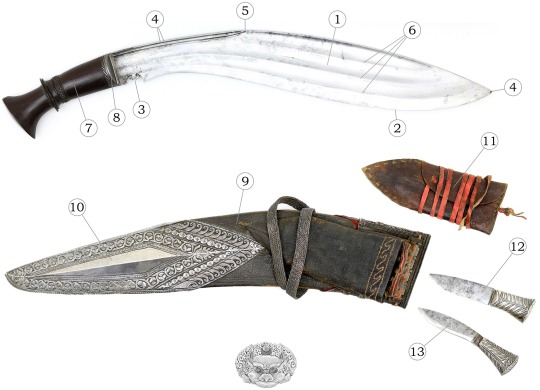
Overview of khukurī parts
# English Devanagari Transliteration
1 Blade बाड़् bāṛ
2 Edge धार् dhār
3 Notch कौड़ो kauro
4 Grooves along the base of the blade खोल् khol
5 Shoulder of blade पातो pāto
6 Ridge (of fuller)* चिरा cirā
7 Grip बिँड़् bĩṛ
8 Bolster काँजो kã̄jo
9 Scabbard दाप् dāp, dāb
10 Silver chape कोथि kothi
11 Purse carried in the sheath खिसा khisā
12 Small utility knife कर्द karda
13 Fire striker / sharpening steel चक्मक् cakmak
*Cirā is the only word in the list that is not directly related to the khukurī in the dictionary, but it is probably the word that is widely known today as chirra.
According to Taylor, cirā is derived of cirnu, literally "To split, rip up, cut, lacerate" is the word used for the ridges between each groove. [2] It is also used in the slightly different form, ciro (चिरो) to describe: "A splinter; cut, slice; (esp.) a slice of cucumber cut lengthwise."
A number of khukurī types are differentiated by the layout of their fullers, or the absence thereof:
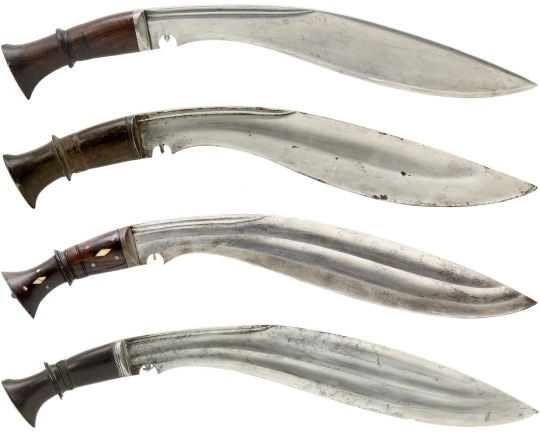
Āṅa (आङ); flat, like a kitchen knife. [3]
Āṅa khol (खोल् आङ); a single fuller running along the spine. (Commonly called ang khola.)
Du'i cirā (दुइ चिरा); "two split", two fullers in the blade. (Commonly called dui chirra.)
Tīna cirā (तीन चिरा); "three split", three fullers in the blade. (Commonly called tin chirra.)
Terms relating to decoration
Buṭṭā (बुट्टा) or buṭo; Embroidery; braid; filigree work.
Bel-buṭṭā (बेल्-बुट्टा); Scroll-work on a khukri-sheath.
Belahari (बेलहरि); Embroidery, scroll-work.
Belahari buṭṭā (बेलहरि बुट्टा); Scroll-work on a khukri sheath.
Jire buṭṭā (जिरे बुट्टा); Fluted ornamentation (e.g. that on the silver of a khukri sheath). Jire means of or like cumin-seed.
Haikale buṭṭā (हैकले बुट्टा) a kind of ornamentation on a khukri handle like a succession of hooks.
Mākhe buṭṭā (माखे बुट्टा); Ornamentation consisting of lines of small dots. Mākhe means "pertaining to flies or like flies.
Sã̄gle buṭṭā (साँगले बुट्टा); Ornamentation in chains.
Materials
Paṭpaṭe (पट्पटे); adjective: Striped. Also a particular kind of tree the wood of which is used for making khukri handles (= bhālu kāṭh). Talauma Hodgsoni also known as Magnolia hodgsonii, or Chinese magnolia.
Gilaṭ (गिलट्); Nickel, German silver. Sometimes used for the bolster of a khukri.
Ispāt (इस्पात्); Steel.
Phaulād (फौलाद्); A kind of hard and tough steel. From the Persian faulād, a name for wootz.
Jhulo (झुलो); Fibre; tinder made of the bark of the sago palm or bamboo or plantain and carried in the pocket of the khukurī sheath.
Relating to the khukurī
Pāin or pain (पाइन्); Blade temper, especially of a khukurī.
Lāgne (लाग्ने); Applicable, sharp (of knife).
Bhutte (भुत्ते); Adjective. Blunt, e.g. bhutte khukri: a blunt khukri.
Ujyāunu (उज्याउनु); To sharpen, give an edge to.
Lagāunu dhār (लगाउनु धार्); to give an edge, sharpen. Lagāunu literally means: To put on, wear (clothes); arrange, fix, set up, plant.
Macāunu (मचाउनु); To make rise, flourish (e.g. a khukri).
Kāṭnu (काट्नु ); To cut, cut off; kill; reap.
Jār kāṭnu (जार् काट्नु) to kill an adulterer. (When the husband has killed the adulterer with his khukri and cut off the nose and hair, he proclaims openly in the village 'jār kāṭẽ' and displays the blood-stained khukri. This proclamation saves him from the accusation of murder.). Jār (जार्) means paramour, adulterer.
Caṛkinu (चड़्किनु); To crack, split (e.g. dewāl caṛkyo the wall cracked, khukuri ko bẽṛ carkieko cha the haft of the khukri is split).
Kāmi (कामि); Blacksmith, iron-worker, armorer. (This is one of the pohoni or despicable castes, and the word kāmi, implying contempt, is often replaced by lohār.)
Lohār (लोहार्) Iron-worker, blacksmith.
Notes
1. Sir Ralph Lilley Turner; A comparative and etymological dictionary of the Nepali language. London: K. Paul, Trench, Trubner, 1931.
2. I owe Jonathan Said for explaining that the chirra actually denote the ridges and not the fullers themselves. Personal communication.
3. Resham Shercha, an ex Gurkha. Personal communication.
136 notes
·
View notes
Text
Eastern Medical College Bangladesh: A Comprehensive Guide for Aspiring MBBS Students

If you're considering MBBS abroad, then you must have come across the name Eastern Medical College Bangladesh. Located in the city of Comilla, Bangladesh, this institution has become one of the popular choices for international students seeking to pursue a medical degree. From its accessible eligibility for Eastern Medical College in Bangladesh to its respectable Eastern Medical College ranking, this medical college is known for offering quality education at an affordable cost.
But what makes this institution stand out? Is it a good fit for you? In this article, we'll take a deep dive into everything you need to know about studying MBBS Bangladesh Eastern Medical College, from the admission process to the overall ranking, fees, and much more.
What is Eastern Medical College Bangladesh?
The Eastern Medical College Bangladesh is a well-established private medical college that was founded in 2005. It is affiliated with Chittagong Medical University and is recognized by the Bangladesh Medical and Dental Council (BMDC). In addition, the institution is listed in the World Directory of Medical Schools, making it a viable option for students wishing to study MBBS abroad.
The college has two campuses, one located in Comilla and the other in Dhaka. The college offers modern infrastructure, experienced faculty, and a comprehensive curriculum that prepares students for medical practice globally. The medium of instruction is English, which is a significant advantage for international students, especially from non-Bangladeshi backgrounds.
Why Study MBBS Bangladesh Eastern Medical College?
You might be wondering why you should choose to study MBBS Bangladesh Eastern Medical College. Here are some key reasons why this institution could be the right choice for you:
Affordable Fees: One of the most appealing aspects of studying at Eastern Medical College Bangladesh is the relatively low tuition fees compared to many Western countries. International students, especially from South Asian nations like India, Nepal, and Sri Lanka, find the financial aspect of this college quite favorable.
Global Recognition: The degree from Eastern Medical College Bangladesh is recognized globally. Graduates are eligible to practice medicine in many countries, including India, the USA, and the UK, after passing the required licensing exams like the USMLE or PLAB.
Modern Infrastructure: The college boasts modern laboratories, a well-equipped library, and state-of-the-art medical equipment. This gives students hands-on experience with the latest technology used in the medical field.
Experienced Faculty: The faculty at Eastern Medical College Bangladesh consists of experienced doctors and educators who are dedicated to providing top-notch education. The curriculum is designed to meet international standards, ensuring that students are well-prepared for their medical careers.
Diverse Student Population: With students from various parts of the world, the environment at Eastern Medical College Bangladesh is culturally diverse. This allows for a rich exchange of ideas and experiences, making the learning environment dynamic and global in nature.
Eligibility for Eastern Medical College in Bangladesh
Before applying to the college, it's essential to understand the eligibility for Eastern Medical College in Bangladesh. Generally, the admission requirements are straightforward, but it's crucial to meet all the criteria to secure a seat.
Educational Qualifications
High School Diploma or Equivalent: The basic eligibility requirement for admission to Eastern Medical College Bangladesh is the completion of high school or an equivalent qualification with a focus on science subjects, particularly Biology, Chemistry, and Physics.
Minimum GPA: International students must have a minimum GPA of 3.5 in their 12th-grade or equivalent examination. This GPA is calculated based on marks obtained in key science subjects like Biology, Chemistry, and Physics.
English Proficiency: Although English is the medium of instruction at Eastern Medical College Bangladesh, non-native English speakers may need to provide proof of English language proficiency. Some students may be required to take TOEFL or IELTS exams to demonstrate their competency.
Entrance Exams
Though Eastern Medical College Bangladesh doesn't usually require entrance exams for international students, some countries may mandate standardized tests for admission. For instance, Indian students must pass the NEET (National Eligibility cum Entrance Test) to apply for MBBS in Bangladesh.
Age Criteria
The student must be at least 17 years old by the 31st of December of the year in which they are seeking admission. The maximum age limit for international students is generally 25 years.
Documents Required
Completed application form
Valid passport
Birth certificate
High school or equivalent certificates and mark sheets
English proficiency test score (if required)
Passport-sized photographs
Eastern Medical College Ranking
When it comes to choosing a college for medical studies, ranking matters. The Eastern Medical College ranking is fairly competitive, especially among the private medical institutions in Bangladesh.
Nationally, Eastern Medical College Bangladesh is often ranked among the top 10 private medical colleges.
Internationally, while it may not rank as high as institutions in the USA or the UK, it is recognized by many global medical bodies such as the World Health Organization (WHO) and the Medical Council of India (MCI).
The Eastern Medical College ranking speaks to the quality of education provided, the faculty's expertise, and the infrastructure available to students. The college has a solid reputation for producing competent medical professionals who go on to succeed in various parts of the world.
The MBBS Curriculum at Eastern Medical College Bangladesh
The MBBS program at Eastern Medical College Bangladesh spans over five years, followed by a one-year compulsory internship. The curriculum is divided into three phases: pre-clinical, para-clinical, and clinical.
Phase 1: Pre-Clinical
During the first two years, students focus on foundational medical sciences like Anatomy, Physiology, and Biochemistry. This stage builds the essential knowledge required to move on to more complex subjects in later years.
Phase 2: Para-Clinical
In the third and fourth years, students are introduced to Pathology, Microbiology, Pharmacology, and Forensic Medicine. These subjects provide a deeper understanding of disease mechanisms, drug actions, and legal aspects of medical practice.
Phase 3: Clinical
The final phase involves hands-on training in clinical settings. Students rotate through various departments such as Surgery, Medicine, Pediatrics, Gynecology, and more. This phase is critical for developing the practical skills needed to become a successful doctor.
Internship
After completing the five-year MBBS course, students are required to undergo a one-year internship in an affiliated hospital. This period is essential for gaining real-world experience and is mandatory for the completion of the MBBS degree.
Fee Structure for Eastern Medical College Bangladesh
The cost of studying MBBS at Eastern Medical College Bangladesh is one of its most attractive features, especially for international students.
Tuition Fees: The total tuition fees range from $35,000 to $45,000 for the entire duration of the course. This is significantly lower than medical schools in countries like the USA or the UK.
Hostel Fees: Accommodation fees are separate and vary depending on the type of accommodation chosen. On average, hostel fees range from $100 to $150 per month.
Other Expenses: Additional expenses such as food, transportation, and textbooks may amount to around $100 per month. However, living costs in Bangladesh are generally affordable for international students.
Life at Eastern Medical College Bangladesh
Studying at Eastern Medical College Bangladesh isn't just about academics; it's also about embracing a new culture and lifestyle. The college offers a vibrant student life, with various extracurricular activities, clubs, and cultural events. International students find it easy to adapt, thanks to the supportive community and student services available.
Accommodation and Hostels
The college provides hostel facilities for both local and international students. The hostels are equipped with modern amenities such as Wi-Fi, air conditioning, and 24/7 security. Separate hostels are available for male and female students, ensuring a comfortable and safe environment.
Cultural Adaptation
One of the challenges of studying MBBS abroad is adapting to a new culture. However, students at Eastern Medical College Bangladesh are welcomed with open arms. The diverse student body and faculty ensure that international students feel at home.
The Advantages of Studying MBBS Abroad at Eastern Medical College
Global Exposure: Studying MBBS abroad gives students exposure to a diverse set of cultures, ideas, and medical practices. At Eastern Medical College Bangladesh, you’ll interact with students and faculty from various countries, broadening your worldview.
Recognition of Degree: The MBBS degree from Eastern Medical College Bangladesh is globally recognized, opening doors for career opportunities in various countries.
Low Cost of Education: Compared to studying medicine in Western countries, Bangladesh offers a far more affordable yet high-quality education.
Safe and Student-Friendly Environment: Bangladesh is a relatively safe country for international students, and institutions like Eastern Medical College Bangladesh provide a secure and supportive environment.
Conclusion
In summary, Eastern Medical College Bangladesh offers an excellent opportunity for students who want to pursue MBBS abroad. With its affordable fees, global recognition, and modern infrastructure, the college stands out as one of the best options for medical education in Bangladesh. The eligibility for Eastern Medical College in Bangladesh is straightforward, making it accessible for many international students. Additionally, the institution's favorable Eastern Medical College ranking speaks to its reputation as a quality medical college.
0 notes
Text
Tbilisi State Medical University: A Comprehensive Guide

Tbilisi State Medical University (TSMU), one of Georgia's most renowned educational institutions, has become a favored destination for students seeking to pursue a career in medicine. With a history dating back to 1918, TSMU has consistently ranked among the top medical universities in Georgia and Eastern Europe, attracting students from around the world. This article provides an in-depth look at the university’s offerings, including its fees, ranking, MBBS program, and why it is an attractive option for students considering MBBS abroad.
History and Legacy of Tbilisi State Medical University
Tbilisi State Medical University was initially established as a faculty within Tbilisi State University in 1918 and became an independent medical institute in 1930. Over the years, it has expanded its reach and influence, offering medical education aligned with international standards. Today, TSMU is a fully accredited institution that offers undergraduate, graduate, and postgraduate programs in various fields of medicine and healthcare.
Tbilisi State Medical University: Key Highlights
Established: 1918
Type: Public
Location: Tbilisi, Georgia
Medium of Instruction: English and Georgian
Accreditation: TSMU is recognized by various international organizations, including the World Health Organization (WHO), the Medical Council of India (MCI), the Educational Commission for Foreign Medical Graduates (ECFMG), and the World Federation for Medical Education (WFME).
Students: Over 7,000 students, including approximately 2,000 international students.
Tbilisi State Medical University Fees
When considering a university for medical education, one of the primary concerns for students is the cost of tuition and overall expenses. Tbilisi State Medical University Fees is known for its relatively affordable fee structure, making it a popular choice for students from countries like India, Nepal, and other parts of Asia and Europe.
Tuition Fees for MBBS Program: The tuition fee for international students pursuing MBBS at TSMU is approximately $8,000 to $12,000 per year, depending on the course and the student's nationality. This fee includes academic expenses but excludes accommodation, food, and other personal expenses.
Other Expenses:
Accommodation: TSMU provides on-campus hostels and off-campus housing options. The cost of living in Tbilisi is relatively affordable, with hostel fees ranging from $1,000 to $2,000 per year.
Living Expenses: The estimated monthly living cost in Tbilisi, which includes food, transportation, and other personal expenses, ranges between $200 to $400 per month, depending on individual preferences and lifestyle.
Tbilisi State Medical University MBBS Fees
Tbilisi State Medical University MBBS Fees is a six-year program that includes five years of academic education followed by a one-year internship. The program is delivered in English, making it accessible to international students who may not be proficient in Georgian.
Curriculum: The curriculum at TSMU is designed to meet international medical education standards and focuses on a combination of theoretical knowledge and practical training. The first three years focus primarily on preclinical subjects such as anatomy, biochemistry, and physiology. The final three years focus on clinical training in various specializations, including surgery, pediatrics, internal medicine, and obstetrics.
Internship and Clinical Exposure: During the final year of the MBBS program, students undergo clinical rotations and internships in affiliated hospitals. This provides them with hands-on experience in dealing with real patients under the guidance of experienced medical professionals. The internships are conducted in hospitals recognized by the Georgian Ministry of Health and international medical bodies.
Global Recognition: Graduates of TSMU are eligible to practice medicine in various countries, provided they clear the respective licensing exams such as the USMLE (United States Medical Licensing Examination), PLAB (Professional and Linguistic Assessments Board) for the UK, or the NEXT (National Exit Test) for India.
Why Choose Tbilisi State Medical University for MBBS Abroad?
There are several reasons why Tbilisi State Medical University is considered one of the best choices for students seeking to pursue MBBS abroad
Affordable Tuition Fees: Compared to countries like the US, UK, or Australia, the cost of studying medicine in Georgia is significantly lower, making it accessible to a wider range of students.
No Entrance Exam: Unlike some countries that require students to pass rigorous entrance exams, TSMU has a simpler admission process, focusing on the student's academic performance in high school.
English-Medium Education: The availability of an English-medium MBBS program eliminates language barriers for international students and ensures they can study comfortably.
International Recognition: TSMU’s degrees are recognized by prominent medical organizations, allowing graduates to work globally.
Cultural Diversity: Tbilisi is a multicultural city that welcomes students from different parts of the world, providing them with a culturally enriching experience alongside their academic pursuits.
Quality Education: The faculty at TSMU comprises highly qualified professors and researchers, many of whom have been trained internationally. The university also places a strong emphasis on research and development.
Tbilisi State Medical University Georgia Ranking
Tbilisi State Medical University Georgia Ranking are important indicators of a university’s global standing, and Tbilisi State Medical University consistently performs well on various ranking platforms.
National Ranking: TSMU is one of the top medical universities in Georgia, often ranking within the top 3 for medical education.
International Ranking: Globally, Tbilisi State Medical University ranks among the top 5,000 universities in the world. Its ranking fluctuates depending on the criteria used by different ranking bodies. For instance, in 2023, it was ranked approximately 4,800th globally, which is impressive for a specialized medical institution.
World Ranking: TSMU’s world ranking is reflective of its strong focus on research, academic excellence, and international collaborations. The university's programs are regularly updated to keep pace with global medical advancements, ensuring that its students receive a modern education that is relevant in today's healthcare landscape.
Tbilisi State Medical University: A Hub for International Students
Over the years, TSMU has attracted a growing number of international students due to its reputable programs, affordable fees, and global recognition. Countries like India, Nepal, Sri Lanka, and several African nations send a large number of students to Georgia every year. The presence of a significant international student community means that Tbilisi offers a supportive environment for foreign students, with cultural events, student associations, and support services specifically designed to help them adapt to their new surroundings.
Tbilisi: A Student-Friendly City
Tbilisi, the capital of Georgia, is a vibrant and historically rich city. It is known for its welcoming nature, safety, and affordability, making it an ideal destination for international students. The city boasts a unique blend of ancient and modern architecture, a rich cultural heritage, and numerous attractions. For students, Tbilisi offers various options for extracurricular activities, dining, and cultural exploration. Moreover, public transport is well-developed, and students enjoy discounts on travel and cultural events.
Conclusion
Tbilisi State Medical University is an excellent choice for students seeking an affordable, high-quality medical education abroad. With its globally recognized MBBS program, affordable fee structure, and a multicultural environment, TSMU offers an exceptional opportunity for aspiring medical professionals. Whether you're looking for world-class medical education, practical experience, or a gateway to global medical practice, Tbilisi State Medical University in Georgia is well worth considering.
For those dreaming of pursuing MBBS abroad, TSMU provides a pathway to achieving a prestigious medical degree in a supportive and diverse environment. From its globally respected faculty to its modern facilities and affordable fees, Tbilisi State Medical University stands as a leading institution in the field of medical education.
0 notes
Text
India’s Experience in Open-Source Technology for Developing Nations
India has emerged as a global leader in open-source technology, establishing a strong foundation for innovation and collaboration both domestically and internationally. Over the past decade, the country’s open-source movement has become popular with many talking about it, allowing it to address critical challenges in education, healthcare, and governance, especially in the context of limited resources making it ideal for most developing nations. Open-source technology has proven to be an effective and affordable solution, bypassing the costly constraints of proprietary software. By embracing this model, India has not only transformed its own technological landscape but has also provided significant contributions to other developing nations.
One of the most remarkable aspects in my opinion of India’s open-source journey is its export of digital public goods to developing nations, particularly in Asia and Africa. For instance, India’s Aadhaar digital identity system, which provides biometric identification to over a billion citizens, has inspired several African countries, including Kenya and Tanzania, to develop similar systems. These countries have been able to leverage open-source solutions to create their own identity frameworks, enabling millions of people to access essential services such as banking, healthcare, and government benefits. This model, which is both affordable and customizable, has greatly reduced these nations’ dependency on expensive proprietary technology, allowing them to take control of their own digital infrastructure.
Similarly, in the healthcare sector, India’s collaboration in the development of DHIS2, an open-source health information system, has revolutionized health management in over 70 countries, including several in Southeast Asia. In nations like Bangladesh and Nepal, DHIS2 has been instrumental in tracking real-time health data, improving disease surveillance, and streamlining healthcare delivery. By offering a customizable platform, this open-source solution has enabled countries with limited resources to develop robust healthcare systems tailored to their specific needs, further illustrating India’s commitment to sharing its technological expertise for global benefit.

India’s active role in empowering developing nations through open-source technology underscores its belief in the importance of affordable, flexible solutions. Open-source technology is uniquely suited for nations where financial resources are scarce but innovation potential is vast. One of the key advantages is that it eliminates costly licensing fees, which can otherwise restrict technological growth. By using and contributing to open-source platforms, developing countries can access high-quality technology without incurring burdensome expenses. In addition, the ability to customize these solutions allows nations to adapt them to local requirements, making them more relevant and effective.
India’s embrace of open-source technology has also contributed to the development of a highly skilled workforce. By fostering collaboration between developers, entrepreneurs, and public-sector entities, India has built a community of tech experts capable of solving not only domestic challenges but also global ones. This growing network of technologists represents a global shift towards collaborative innovation, where countries work together to drive shared growth rather than remaining dependent on proprietary software from multinational corporations.
Perhaps one of the most important benefits of open-source technology is the sovereignty it grants over data. In an era where data security is a growing concern, especially for developing nations, open-source technology provides a safeguard. Governments can retain control over sensitive information, rather than relying on foreign tech companies, ensuring that their data remains secure and is used in alignment with national interests. This autonomy over data management is crucial for countries that are keen to avoid tech dependency and establish digital sovereignty.
Despite India’s success with open-source technology, challenges remain. Many developing nations still face significant infrastructure gaps, such as limited internet connectivity and power shortages, which can hinder the full adoption of digital technologies. Additionally, the very nature of open-source systems, which often lack the corporate backing of proprietary solutions, requires greater government investment in education and training to build local expertise. Without addressing these gaps, it may be difficult for some countries to harness the full potential of open-source technology.
India’s open-source journey, while impressive, is only a starting point. Its success shows that open-source technology can be a powerful tool for reducing global inequality, fostering innovation, and building stronger, more self-reliant nations. However, the journey toward tech equity requires global collaboration, consistent investment, and a commitment to bridging the digital divide. If these challenges are addressed, open-source technology will undoubtedly play a central role in shaping the future of developing nations.
India’s experience with open-source technology offers a model for other countries looking to build their own digital futures. By embracing open collaboration, developing localized solutions, and investing in digital infrastructure, India has proven that technological independence is achievable, affordable, and scalable. As more nations follow in India’s footsteps, we can expect a global shift towards greater tech equity and innovation, paving the way for a more inclusive and sustainable digital future.

#open source tech#conflict#foreign policy#india#tech#aid#ai#ai and tech#collaboration#foreign aid#foreignaid#open source objects#open source software
0 notes
Text
Pursuing MBBS in Nepal: A Comprehensive Guide for Aspiring Medical Students

Choosing a career in medicine is a significant decision, and finding the right place to pursue it is just as important. MBBS in Nepal has become an increasingly popular option for international students, especially from neighboring countries like India. The country offers high-quality education, affordable fees, and an opportunity to study in a diverse and culturally rich environment. In this guide, we’ll explore why Nepal has emerged as a prime destination for medical education and provide details about its leading institutions, including Kathmandu University and Tribhuvan University.
Why Choose MBBS in Nepal?
One of the most attractive aspects of pursuing MBBS in Nepal is the combination of quality education and affordability. Nepal has numerous medical colleges that are recognized by the Medical Council of India (MCI) and are also listed in the World Directory of Medical Schools. This ensures that graduates from Nepal are eligible to practice medicine not only in Nepal but also in India and many other countries after passing the necessary licensing exams.
Here are some key reasons why students opt for MBBS in Nepal:
Affordable Tuition Fees: Medical education in Nepal is more affordable compared to private medical colleges in India. Students get access to world-class education without the burden of excessive costs.
No Language Barrier: English is the primary medium of instruction in Nepalese medical colleges, which makes it easier for international students to follow the curriculum.
Cultural Similarities: For students from India, the cultural and geographical proximity of Nepal makes it a comfortable and familiar place to live and study. The shared customs and languages enhance the student experience.
MCI-Approved Institutions: Many colleges offering MBBS in Nepal are approved by the Medical Council of India, ensuring that graduates can return to India and practice medicine after clearing the FMGE (Foreign Medical Graduate Examination).
Top Universities for MBBS in Nepal
Nepal is home to some of the most prestigious medical universities in South Asia, and two stand out for their academic excellence: Kathmandu University and Tribhuvan University.
Kathmandu University
Kathmandu University is one of the premier institutions for medical education in Nepal. Established in 1991, the university is renowned for its well-structured curriculum, experienced faculty, and state-of-the-art facilities. The MBBS in Kathmandu University program follows international standards, making it an ideal choice for both local and international students.
Some highlights of Kathmandu University’s MBBS program include:
Modern Teaching Methods: The university employs innovative teaching methods, including interactive sessions, problem-based learning, and clinical exposure from the early years of the program.
Global Recognition: Degrees from Kathmandu University are recognized by medical councils across the world, including the MCI and WHO. Graduates from the university can pursue careers in countries like India, the USA, Canada, and Australia after completing the necessary licensing exams.
Experienced Faculty: The university boasts a highly qualified faculty with extensive experience in the medical field, ensuring that students receive top-notch education and guidance.
Tribhuvan University
Tribhuvan University, established in 1959, is the oldest and largest university in Nepal. The Institute of Medicine (IOM) at Tribhuvan University offers one of the most respected MBBS programs in the country. The university is known for its rigorous academic curriculum and comprehensive clinical training, making it a top choice for aspiring doctors.
Key features of the MBBS program at Tribhuvan University:
Strong Clinical Exposure: Tribhuvan University places a strong emphasis on clinical training, allowing students to gain hands-on experience in real-world medical settings. This ensures that graduates are well-prepared for their future careers.
Research Opportunities: Students at Tribhuvan University are encouraged to participate in medical research, providing them with valuable experience and knowledge that can set them apart in their professional careers.
Affiliated Hospitals: The university has a network of affiliated hospitals, where students can gain practical experience and work alongside experienced medical professionals.
Admission Process for MBBS in Nepal
The admission process for MBBS in Nepal is straightforward, and the eligibility criteria are designed to be accessible for a broad range of students. Here’s a breakdown of the typical requirements:
Eligibility: Students must have completed their 12th-grade education with a minimum of 50% marks in Physics, Chemistry, and Biology. Additionally, students need to pass an entrance exam conducted by the respective universities or by the Medical Education Commission of Nepal.
Entrance Exam: Most universities in Nepal, including Kathmandu University and Tribhuvan University, require students to appear for an entrance exam. The exam tests students' knowledge in subjects like Physics, Chemistry, Biology, and English.
Application Process: After clearing the entrance exam, students can apply to their chosen university. The application process usually involves submitting academic transcripts, passport-sized photographs, and other necessary documents.
Living in Nepal as a Student
Apart from the academic advantages, studying MBBS in Nepal offers students a unique cultural experience. Nepal is known for its stunning natural beauty, with the majestic Himalayas and vibrant cities offering plenty of opportunities for exploration.
Affordable Living: The cost of living in Nepal is relatively low, making it easier for students to manage their expenses. Accommodation, food, and transportation are affordable, especially when compared to other countries offering medical education.
Student-Friendly Environment: Nepalese people are known for their warm hospitality, and international students often find it easy to settle into their new environment. The country is also very safe, with low crime rates, which is another advantage for students living abroad.
Cultural Richness: Nepal is home to diverse cultures, languages, and traditions. Students studying MBBS in Nepal can immerse themselves in this rich cultural heritage, making their academic journey more fulfilling.
Conclusion
Pursuing MBBS in Nepal offers an excellent opportunity for students seeking a high-quality education in medicine at an affordable cost. With prestigious institutions like Kathmandu University and Tribhuvan University, students can expect to receive a world-class education that prepares them for a successful medical career. Moreover, the cultural richness and natural beauty of Nepal make it a unique and rewarding place to live and study.
If you’re considering a career in medicine, exploring the option of MBBS in Nepal might just be the right step towards achieving your goals.
0 notes